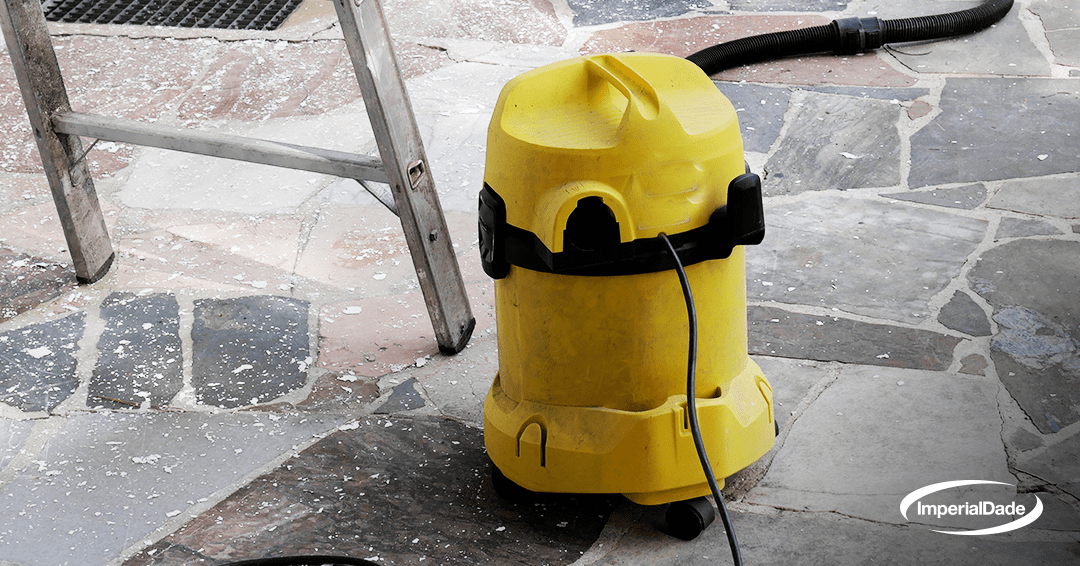Whether dealing with liquid spills on a carpet, messy slurry on your tile floors, or even a large chunk of dry debris, the wet/dry vac can handle it all. Coming in a wide variety of sizes and shapes, these cleaning machines are a must-have for any business or commercial setting.
Despite the variety, wet/dry vacs are quite easy to use.
In this guide, we will show you how to use a wet/dry vac like a pro, taking you through each step to ensure your facility’s floors stay nice and clean.
How to Use a Wet Dry Vac in 5 Steps
While wet/dry vacs can differ greatly in size and shape, the basic operation is similar.
There are the five steps to using a wet/dry vac:
- Choose the Right Filter
- Attach Accessories
- Start Vacuuming
- Empty the Recover Tank
- Clean and Maintain the Recovery Tank
Step 1: Choose the Right Filter
Before using your wet/dry vac, make sure it has the appropriate filter isntalled.
Start by detaching the motor cover assembly, which will have a clasp or latch on either side. Lift it up to access the filter and motor.
There are two different kinds of filters: wet filters and dry filters.
Wet filters, typically made from synthetic, open-weave materials, are designed for liquid pickups, like cleaning slurry, grease, or other spills.
Dry filters are often pleated or cloth and can be used for an assortment of dry debris pickup, like construction debris or fine particulate pickup.
Using the incorrect filter can damage the vac’s motor and other internal components. So, always ensure you select the right one. Secure the motor cover assembly in place once you’ve confirmed the filter type.
After the correct filter is in place, you can attach any accessories to your wet/dry vac that you plan on using to clean up the spill or debris at hand.
Step 2: Attach Accessories
If you have accessories, like an extension wand or a front-mounted squeegee, you can attach them now. Accessories are optional, so it’s up to your discretion when to use one.
Most of the time, attaching accessories is straightforward.
Most attachments have an inlet or port they screw into or clasp onto. For a wand, push it on the end of the long hose. For a front-mount squeegee, use the short hose.
With your accessories properly attached, it’s time to start vacuuming.
Step 3: Start Vacuuming
Plug your wet/dry vac into a wall outlet or air pump and power it on.
Liquid Removal
For liquid removal, simply make overlapping passes with the wand or front-mounted squeegee, similar to how you would use an autoscrubber.

Dry Pickup
For dry pick up, use the hose to suck up any large debris. If you’re cleaning up dust or other fine particulates, the wand attachment and floor tools should be used.
Once you’ve vacuumed everything up, you’ll have to empty the recovery tank.
Step 4: Empty the Recovery Tank
When the recovery tank is full, it’ll need to be emptied.
Remove the motor cover assembly and filter to reveal the accumulated debris in the tank. Dry debris has to be removed by hand and disposed of in a trash bag or waste bin. For liquids, either tilt the machine or use the provided drain hose to empty it.
Now that you’ve emptied the recovery tank, all that’s left is to clean it.
Step 5: Clean and Maintain the Recovery Tank and Filter
Cleaning the recovery tank is absolutely crucial for proper maintenance.
The above statement is particularly true of wet debris. You want to rinse the tank and filter thoroughly to remove any residue left by the debris. Clean the inside of the recovery tank using suitable cleaning agents for the material it’s made from, and ensure the interior is entirely air-dried once you’re done.
Final Thoughts
These five simple steps, choose the right filter, attach accessories, start vacuuming, empty the recovery tank, and clean and maintain the recovery tank, are all you need to know to use a wet/dry vac effectively.
These versatile machines have the ability to make your cleaning routine more efficient and effective; they just need to be used properly. If you have further questions or are interested in acquiring a wet/dry vac for your facility, consider reaching out to an Imperial Dade facility near you.
One of our janitorial equipment specialists can perform a free evaluation of your floorcare program to determine the suitability of a wet/dry vac for your specific needs.
